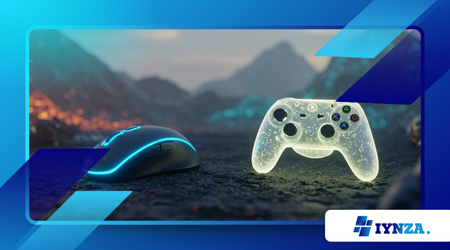Mouse vs. Controller: Which Is Better Based on the Game You Play?

Have you ever finished a match and wondered if you’d have performed better using a different input? Maybe your aim felt off, or your movement felt clunky, and suddenly you’re questioning whether the tool you used held you back.
Anúncios
The truth is, when it comes to Mouse vs. Controller, there’s no one-size-fits-all answer. It all depends on the type of game you’re playing.
Some genres demand precision. Others reward fluid motion or pressure-sensitive inputs. Understanding the strengths of each control method helps you decide what gives you the edge—not just in theory, but in practice.
This article will break down exactly when each input works best, so you can stop guessing and start optimizing your performance.
Why the Mouse Still Rules First-Person Shooters
Precision is the name of the game in first-person shooters. When reaction time is measured in milliseconds and headshots define the scoreboard, nothing compares to a mouse. You can aim faster, flick more accurately, and fine-tune your sensitivity down to the pixel.
In titles like Counter-Strike 2, Valorant, and Overwatch 2, mouse and keyboard remain the standard for high-level play.
There’s no aim assist, and tracking an opponent mid-fight requires complete control. The mouse offers that kind of fine-grained movement. It responds instantly to small adjustments and allows for broader arm-based aiming—something thumbsticks simply can’t replicate.
Even in games like Call of Duty, where aim assist for controllers is stronger, PC pros often stick to mouse input because of the freedom it provides. The control scheme aligns with how FPS games are designed at their core—fast, reactive, and unforgiving.
In raw shooting mechanics, the mouse doesn’t just compete—it dominates.
Read also: Gaming Addiction: How to Find a Healthy Balance
Why Controllers Excel in Fighting, Racing, and Platform Games
Not every game is built around aim. For many genres, the mouse is simply out of place.
In fighting games like Street Fighter or Mortal Kombat, controllers feel more natural. The directional pad allows for cleaner execution of combos, the button layout favors muscle memory, and the ergonomics reduce strain over long sessions.
Racing games also benefit heavily from analog input. Triggers allow for gradual acceleration and braking. Joysticks provide better cornering control. A keyboard’s binary input—either on or off—just doesn’t offer the same nuance.
The same logic applies to platformers and sports titles. Whether it’s the precise timing of a double-jump or the seamless control over a dribble or slide, controllers give players a more fluid, immersive feel. The physical design was made for it.
In these genres, the choice is clear. The controller isn’t just more comfortable—it delivers results through design.
Some Games Don’t Take Sides—They Reward Adaptability
Then there are the games that don’t clearly favor one input over another. Open-world RPGs, third-person shooters, action-adventure titles, and cross-platform competitive games often allow players to choose.
Take Elden Ring, for example. Many players prefer a controller for combat and movement, especially due to how rolling, blocking, and weapon switching feel. But when it comes to inventory management, some switch to mouse and keyboard for faster navigation.
In games like Fortnite, controller players benefit from strong aim assist, but mouse users have faster building mechanics and more accurate edits. The preferred input often comes down to what aspect of the game you value most—combat, mobility, or precision.
That flexibility gives players an advantage—if they’re willing to adapt. The most competitive users learn to switch inputs when it benefits them instead of sticking to a single method out of habit.
Choosing Tools, Not Sides
This debate shouldn’t be about loyalty. It should be about performance. The best players are the ones who ask, “What tool makes me play better in this game?”
The mouse is best when you need speed and accuracy, controller wins when fluid movement, analog input, and tactile comfort matter more. And in some games, the real power lies in understanding how to switch between the two.
Input isn’t just a personal choice. It’s a strategic one.
A Stat That Clarifies the Debate
In a 2024 industry-wide report by GameInput Analytics, mouse users in competitive shooters had a 21% higher headshot rate than controller players. But in fighting games, controller users executed multi-input combos with 33% fewer input errors. And in racing games, analog input from controllers reduced cornering mistakes by 18%.
This data proves what many players already sense: the ideal input depends entirely on the gameplay demands. There is no universal winner—only contextual advantage.
What Are You Prioritizing—Comfort or Performance?
Many players stick to what’s familiar, even when it works against them. If you’re consistently losing aim battles or struggling with movement, ask yourself: are you using the input method that best matches the game’s mechanics?
Switching input might not feel comfortable at first. But if it leads to cleaner execution, faster decision-making, and more wins—it might be the adjustment you’ve needed all along.
Conclusion
The Mouse vs. Controller conversation doesn’t need a final answer. It needs a smarter question: “Which one is right for this moment, in this game, with my current goal?”
FPS titles reward accuracy and reaction time—fields where the mouse shines. Fighting games, racers, and platformers rely on analog nuance—where controllers clearly lead. And in hybrid games, the advantage goes to those who can shift freely between inputs without sacrificing comfort or control.
Your input method isn’t your identity. It’s your instrument. And like any serious player, choosing the right tool for the job can make all the difference.
FAQ
1. Is mouse and keyboard always better for FPS games?
For PC-based FPS titles, yes. The combination offers faster and more accurate aim than controllers.
2. Can I switch between mouse and controller while playing?
Many modern games support seamless switching. Titles like Apex Legends and Halo Infinite allow you to change inputs mid-session.
3. Is controller better for beginners?
In many genres, yes. Controllers are more ergonomic and easier to learn for new players.
4. Why is controller preferred in fighting games?
The layout allows for smoother combo execution, better directional input, and more responsive gameplay.
5. Should I invest in both input methods?
If you play a variety of genres or platforms, having both gives you more flexibility and control.
